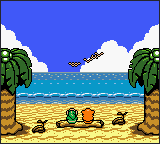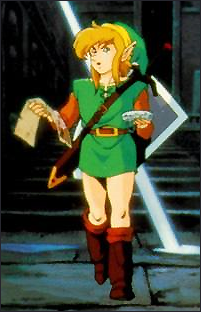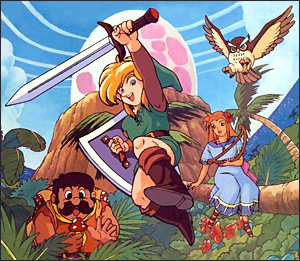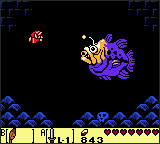Review: Link’s Awakening by DuckNoises
Posted on June 12 2011 by Legacy Staff
Link’s Awakening originally came out for the Game Boy in 1993 to excellent reception. In an attempt to revitalize the game and increase sales,Link’s Awakening was released a second time for the Game Boy Color in 1998 with additional features and, as one would expect, the game was in colour. In a similar fashion, the game has once again been released for the 3DS Virtual Console.
This review will highlight the game and its features, often likening it to the other games in the franchise’s history to show how it fares in comparison.
Plot, Atmosphere, and Characters
Link’s Awakening takes place after the hero of A Link to the Past sets out to the sea in search of adventure, having recently saved Hyrule from a crisis. Caught in a thunderstorm, Link’s ship is capsized; washed up onto a beach, and stricken with amnesia, Link can’t recall where he is or where he was going. Told he is on the isle of Koholint, Link is faced with the task of rediscovering himself and learning about his surroundings. He is told of a mystical entity called the Wind Fish, which has lain dormant for eons on top of a mountain inside of a giant egg; in order to learn the truth, he sets out to crack the riddle of this enigmatic isle.
Unlike many other Zelda games, Link’s Awakening has a relatively unorthodox narrative structure, in that the plot is not event-driven; rather than being faced with a crisis to halt and a land to save, the crises of Link’s Awakening function in a very different manner, with emphasis on characters and themes, rather than events, that are almost entirely existential. Link is faced with no princess, nor any apparent villain – only the mystery of the island. The absence of an event-driven plot allows for the weaving of metaphor and imagery as the player is further engulfed in the mystery. Throughout the whole game, the underlying reason for why Link is going anywhere isn’t to save the day, flipping the stereotypical plot line on its head; despite there being no real overwhelming evil to thwart, the intrigue is more than enough to keep you playing.
The atmosphere of Link’s Awakening is notably surreal; it draws you into its folds with the initial intrigue of not knowing where you are and what you’re doing on Koholint, not even where your quest will lead you. This is cleverly employed to put the drive of the story onto the player, with the quest ahead seeming foreboding, but occasionally leaning towards the absurd. The majority of the story’s progression takes place in the player’s mind as they unravel the clues of the island towards the end of the game, while most of the game’s characters show a lack of concern. The increasing gravity of the story’s implications stands in stark contrast to the mysterious lack of reaction from the characters and provides an immersive sense of tension; because of the lack of actual “events” in the plot line, the game manages to become more immersive because the player is never put off by anything predictable or cheesy.
To contrast the tension, many of the characters are zany and eccentric, in polar opposition to the level of the seriousness in the plot line. The characters’ bizarre and utter obliviousness to the game’s happenings add a level of disbelief to the plot. The dialogue and nature of the characters is often hilarious; there is a frequent pattern where characters will break the fourth wall. Many of the characters explain the control scheme to Link early on in the game, and note how it is a significant improvement in technology, or ponder the significance of what they had just said in breaking the fourth wall. There are numerous references to the Mario, Yoshi, and Kirby franchises, making the player incredulous to contrast the engulfing mystery of the island.
There is a fairly large amount of character development, despite the absence of any formative events to shape the characters’ personalities. Much of this is seen in the two primary characters. The first of these is the protagonist, Link; because of Link’s amnesia, the player puts themselves in Link’s shoes as he rediscovers himself and uncovers the reality of his surroundings. The game even makes a graceful attempt at a romantic subplot, which is occasionally done in a very clunky fashion in some adventure games. Fortunately, all the characters are dynamic, interesting, and funny; all of the characters, even the minor ones, have multiple layers. Many of the characters even poke fun at some of the mechanics of the Zelda series, with parodies of classic Zelda moments from earlier games. The characters are always a pleasure, and complement the story cleverly.
Ultimately, Link’s Awakening walks a delicate tightrope between belief and disbelief; fortunately, it is a balance that rarely falters. The plot iselegant and poignant, stemming from its original narrative structure. The plot never fails to beguile the player into a true connection with the characters and the island of Koholint, but manages to leverage some distance to keep you always questioning what you see and hear in the game. This game and its story will keep you thinking about it constantly, as it is bursting to the seams with profundity and humour. The game’s ending deserves mention, as it is one of the most powerful endings I have ever seen in a video game, leaving a significant impression that can push the boundaries of the possible depth video games can possess. The game stands as a great achievement of storytelling and an ageless work filled with cleverness and intrigue.
Graphics
Surprisingly, the 18 year-old sprites from Link’s Awakening still hold up pretty well. They don’t look half bad compared to their 16-bit counterparts from their predecessor, A Link to the Past, and those weren’t on a hand-held device. Although the sprites are quite small on a hand-held screen, there is little difficulty in identifying features on sprites and making distinctions. Despite the game’s age, the animations and sprites are still very effective and pleasant on the eyes.
 The biggest difference between the original Link’s Awakening for the Game Boy and the re-released Link’s Awakening DX for the Game Boy Color is, not surprisingly, the presence of colour. At the time of its original release, the absence of colour was a minor quibble, and the black and white images were good enough; after having played the game both in black and white and colour versions, there is actually a noticeable difference. The original version of the game feels much more sombre due to the absence of colour, and brings the more serious elements of the game to the forefront. Unfortunately, the lack of colour makes Koholint feel a little drab, and it detracts slightly from the game’s impeccable charm.
The biggest difference between the original Link’s Awakening for the Game Boy and the re-released Link’s Awakening DX for the Game Boy Color is, not surprisingly, the presence of colour. At the time of its original release, the absence of colour was a minor quibble, and the black and white images were good enough; after having played the game both in black and white and colour versions, there is actually a noticeable difference. The original version of the game feels much more sombre due to the absence of colour, and brings the more serious elements of the game to the forefront. Unfortunately, the lack of colour makes Koholint feel a little drab, and it detracts slightly from the game’s impeccable charm.
Nintendo’s decision to re-release Link’s Awakening in colour in the form of Link’s Awakening DX is entirely justified. If Nintendo could only bring a few original GameBoy titles from black and white to colour, Link’s Awakening would be the first choice. The fully-coloured Koholint is vibrant and beautiful, with very bright elements strategically placed in the more whimsical parts of the game. This greatly accentuates the game’s sense of zaniness, and brings an excellent balance between the serious and humorous segments of the game. It also makes the landscapes and characters that much more memorable.
Sound
The game’s sound effects are fairly standard, limited mostly by the fact that the game was released on an early hand-held system. There are a couple of unique sound effects made by bosses in place of some of the generic boss noises made in earlier Zelda games. These sound effects match the animations nicely, but there isn’t anything particularly noteworthy.
The music for the game is what really stands out. The melodies are delightful, and often bright and catchy. There are more melancholic shades to the soundtrack, though, and they are well dispersed throughout, more often in the dungeons. The dungeons themselves are noteworthy –for the first time in the Zelda series, each dungeon was given unique background music. Most of them are well suited to their respective dungeon and provide a distinct atmosphere for each locale.
There are a few occasional variations on riffs from the original Legend of Zelda interspersed throughout the melodies of Link’s Awakening, bringing a sense of familiarity to the unusual and foreign Koholint. The theme to Tal-Tal Heights, a mountainous area of the island, is particularly strong and provides a heroic, grandiose feeling to the region as the player approaches the Wind Fish Egg.
However, none of these themes hold a candle to the game’s primary piece of music, The Ballad of the Wind Fish. It is dramatic and haunting, bringing the implications of the Wind Fish to the forefront of your mind. The melody is absolutely enthralling, as remarked by several NPCs in the game. Its mysterious tone will keep the message and feeling of Link’s Awakening as a whole resonating in your head for the entire adventure.
The controls of Link’s Awakening are simple and responsive, very much akin to what was seen in A Link to the Past. However, there are a few key differences in the interface; most notably, the ability to select two items for use instead of being required to use the sword and a choice of one other item. This, as explained in-game, allows for many different play styles. The game does an excellent job of encouraging this by having most enemies susceptible to different kinds of attacks, with each method to combat having its own specific and balanced pros and cons. There are even several combinations of items that have unique properties when used at the same time, giving rise to unique results in practice.
The game also features an Ocarina with multiple songs, each with several functions, in what was likely the inspiration for the Ocarina inOcarina of Time. More songs are gathered throughout the main quest, and have both uses to further yourself in the main quest and uses for more general, common occurrences.
Aside from standard, top-down viewpoints, Link’s Awakening features the occasional side-scrolling, 2D segment. Although it initially sounds akin to the side-scrolling found in The Adventure of Link, it actually has little in common with that game. Unlike the items that were left virtually unused in The Adventure of Link, Link’s Awakening fully incorporates items into solving puzzles and fighting enemies in both the normal, top-down perspective and the less frequent side-scrolling sections in multiple ways. These side-scrolling areas are normally found underground or underwater, in transition from one area to the next. This keeps them from feeling out of place or odd in the game, acting effectively as segues.
In general, the difficulty of game play in Link’s Awakening is gauged very well, remaining challenging, but less brutal than some of its predecessors in terms of combat. This is balanced out well by having more complex puzzles in the game than A Link to the Past. For a veteran 2D Zelda player, Link’s Awakening should remain challenging enough to hold your interest and keep you on your toes, but don’t expect anything overly frustrating. Again, in terms of difficulty, Link’s Awakening ranks slightly lower than A Link to the Past, obtaining a difficulty level similar to, if not slightly harder than the more recent Oracle games. For Zelda fans that have only had experience with the newer hand-held games, Link’s Awakening is a significant increase in difficulty. It will certainly be a major step up from games like Phantom Hourglass and Spirit Tracks.
Overall, the difficulty of Link’s Awakening is one of the best managed in the series, with significant complexity to warrant difficulty, but with little gimmickry and much more genuine, good old-fashioned challenge that never strays towards brutality.
Although the overworld in Link’s Awakening is generally stellar, there is a blemish in the linearity of the beginning of the game. From the get-go, the player is given little chance to explore the overworld, as much of it is blocked with obstacles that cannot be overcome until the player acquires more items by finishing some of the earlier dungeons. For the first two or three dungeons, there is little deviation allowed from the main quest, which I found fairly frustrating. However, Koholint opens up nicely after a few of the earlier dungeons are cleared, which allows for a much less linear experience filled with side quests and collectibles, giving way to a much richer game.
Link’s Awakening contains substantially more dialogue-based events than its combat-heavy predecessor, which is only to be expected in a more story-driven game. These can be anything from side quests to Easter Eggs to mini-games scattered throughout, and there truly is a lot of variety in this regard.
Despite some initial issues with linearity, much of the game play in Link’s Awakening is balanced, varied, and ultimately satisfying. Many of the game’s problems are overshadowed by the much larger proportion of the game that excels in its goals.
Dungeons
 The dungeons in Link’s Awakening were the beginning of the standard formation of dungeons in Zelda games today, with a Compass, Map, and Boss Key; however, there is a new distinction from the Big Key of A Link to the Past in that the Boss Key is only used once in the dungeon to open the door to the boss. In addition to the regular dungeon-specific items, there is also the Owl’s Beak (or piece of a stone tablet in the non-DX version). This item is part of an Owl Statue (or stone tablet) which, when completed, serves a similar purpose to the structures on the wall in A Link to the Past used to communicate with Sahasrahla, providing a hint to deal with some of the more difficult elements of the dungeon.
The dungeons in Link’s Awakening were the beginning of the standard formation of dungeons in Zelda games today, with a Compass, Map, and Boss Key; however, there is a new distinction from the Big Key of A Link to the Past in that the Boss Key is only used once in the dungeon to open the door to the boss. In addition to the regular dungeon-specific items, there is also the Owl’s Beak (or piece of a stone tablet in the non-DX version). This item is part of an Owl Statue (or stone tablet) which, when completed, serves a similar purpose to the structures on the wall in A Link to the Past used to communicate with Sahasrahla, providing a hint to deal with some of the more difficult elements of the dungeon.
The dungeons are fairly challenging, with more complicated puzzles than those found in A Link to the Past, and easily some of the harder puzzles in all of the 2D Zelda games. The puzzles range from very small segments to get a Small Key or unlock a door to much more complex puzzles that utilize many different elements of the dungeon. The latter of the two is where the Owl Statues come in handy, avoiding issues with difficulty that may have risen from trickier puzzles. The trickiest of these puzzles are often the most innovative, often altering the dungeon drastically or opening up entirely new pathways.
One minor quibble with the game’s dungeons is that they occasionally feel short, particularly after completing one of the larger puzzles. After completing some of the harder parts of the dungeon, the rest of it can tend to feel very straightforward. Combat in dungeons remains fairly challenging, often dispersed between puzzles to maintain a balanced feel to the dungeons, making good use of the dungeon item. Dungeons feature both at least one mini-boss and a dungeon boss, among some fairly unique enemies to that specific dungeon.
Overall, the dungeons flow well and are challenging, with every dungeon feeling different from the last and being among the better ones in the series.
There is also a secret, additional dungeon exclusive to the DX version, based entirely on the addition of colour to the game. The dungeon is difficult to find, but is well worth it, with numerous secrets and a number of unique bosses. The dungeon uses colour creatively and effectively in both its puzzles and enemies, with some truly engaging and delightful puzzles. Although the dungeon is secret, there is additional incentive to finding it.
Bosses
The bosses of Link’s Awakening are numerous and largely creative. Although figuring them out isn’t particularly difficult, actually putting your ability to damage the bosses into practice is harder than it is in theory. Because of very few gimmicks, the bosses tend not to be frustrating and dying in the game never seems unwarranted, because the bosses usually end up being as hard as they should be, and beating them feels like an accomplishment more than a chore. That isn’t to say that there isn’t the occasional pushover, but by and large, the bosses are challenging and diverse.
Aside from the regular dungeon bosses, the mini-bosses are also well done, most of them being as creative and unique as the dungeon bosses. Certain mini-bosses reappear throughout the game in later dungeons, sometimes coming back with new tricks or in greater numbers to act as standard obstacles in the later dungeon aside from that dungeon’s new mini-boss.
Another excellent factor to the bosses in the game are that they can often be defeated in a myriad of different ways that incorporate many different combinations of items. Finding a new way to beat every boss adds a lot to the variety in subsequent attempts, and can make people have fairly different experiences with certain bosses. Each way has its own advantages, and keeps figuring out how to beat the bosses from being incredibly simple.
One of the more interesting additions to Link’s Awakening is the appearance of bosses outside of the dungeons; this keeps the inter-dungeon segments interesting and diverse, and tends to keep the player on their toes because these kinds of bosses can crop up in places the player might not expect. Although these bosses aren’t always quite as hard as they could be, the thrill of finding them is always an added pleasure and they are certainly appreciated.
Replay Value
 One of the DX version’s best attributes is its replay value. Aside from the addition of colour, the DX version has unique scripted events that come about in the form of a scrapbook. Performing certain tasks in the game at a certain time will unlock a new picture and comment for your scrapbook, which can be looked at in the Photo Shop found in the DX overworld. Whenever you find one of these photo opportunities, there are unique character interactions and dialogue that add new elements to the game’s story and charm, adding additional pieces to the puzzle. This adds new layers to the game for the second or third time through, especially because these scrapbook pictures can be so elusive. Finding all of them in a single shot is extremely difficult, particularly if you are trying to unlock the game’s secret ending. This is a very clever addition to the game that will keep you coming back to Link’s Awakening.
One of the DX version’s best attributes is its replay value. Aside from the addition of colour, the DX version has unique scripted events that come about in the form of a scrapbook. Performing certain tasks in the game at a certain time will unlock a new picture and comment for your scrapbook, which can be looked at in the Photo Shop found in the DX overworld. Whenever you find one of these photo opportunities, there are unique character interactions and dialogue that add new elements to the game’s story and charm, adding additional pieces to the puzzle. This adds new layers to the game for the second or third time through, especially because these scrapbook pictures can be so elusive. Finding all of them in a single shot is extremely difficult, particularly if you are trying to unlock the game’s secret ending. This is a very clever addition to the game that will keep you coming back to Link’s Awakening.
Aside from the scrapbook, the DX version also features the previously mentioned additional dungeon; there is even a choice between two substantial combat upgrades to be found in the game that reflects your combat play style. Each choice has the potential to accentuate different styles in fighting enemies, which compels you to fight enemies in different ways every time you beat the game.
Both versions of the game are very enjoyable to play again, certainly some of the best to replay in the entire series, particularly the DX version.
Overall Comments
Due to its recent fall into relative obscurity, Link’s Awakening has become a hidden gem of sorts for the Zelda franchise as of late. This game is the birthplace of the charm and eccentricity that is found in Zelda, and not without reason, because its undeniable charm is something that remains as great as it ever was. This game still has an incredibly powerful story that is one of the best in the franchise’s history, with depth and intrigue that few can hold a candle to. Although the DX version sports numerous advantages over the original GameBoy title, both are incredible experiences. Despite its current scarcity, I highly advise everyone to find this game either through used game shops or eBay, or go the recently added, simpler route by buying it on the eShop. It’s just a brilliant game.





